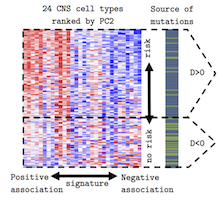Abstract
Recent studies have identified many genes with rare de novo mutations in autism, but a limited number of these have been conclusively established as disease-susceptibility genes due to the lack of recurrence and confounding background mutations. Such extreme genetic heterogeneity severely limits recurrence-based statistical power even in studies with a large sample size. Here, we use cell-type specific expression profiles to differentiate mutations in autism patients from those in unaffected siblings. We report a gene expression signature in different neuronal cell types shared by genes with likely gene-disrupting (LGD) mutations in autism cases. This signature reflects haploinsufficiency of risk genes enriched in transcriptional and post-transcriptional regulators, with the strongest positive associations with specific types of neurons in different brain regions, including cortical neurons, cerebellar granule cells, and striatal medium spiny neurons. When used to prioritize genes with a single LGD mutation in cases, a D-score derived from the signature achieved a precision of 40% as compared with the 15% baseline with a minimal loss in sensitivity. An ensemble model combining D-score with mutation intolerance metrics from Exome Aggregation Consortium further improved the precision to 60%, resulting in 117 high-priority candidates. These prioritized lists can facilitate identification of additional autism-susceptibility genes.
